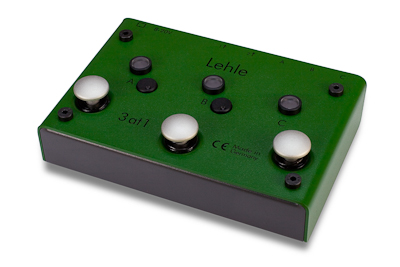
Lehle 3AT1 SGOS
You might also want to connect with us on Facebook, YouTube, Instagram, or by email.
Out of stock
There can’t be anyone, anywhere, who doesn’t know what a drag it can be swapping cables when changing instruments during a gig! So eliminate it – with the Lehle 3at1 SGoS! This True Bypass pedal switches the signals from magnetic and piezo pick-ups just as free of losses and background noise as it does line signals. The secret is in its gold-plated-contact relays and its active pop-and-click suppression. Any differences in level can be ironed out, and Outputs A and B lowered relative to C.
You can also feed signals from totally different sound sources, such as keyboards and CD/MP3 players, to an amp or a PA channel. All inputs and outputs, plus the internal signal path, are stereo. Press the active footswitch again to route the signal to the second output, and thus to an instrument tuner, another amp, or a mixing console channel.
The Lehle 3at1 SGoS can be remote controlled using MIDI program change commands. You can also network the unit with other Lehle SGoS switchers via a stereo jack socket. Cable swapping to change instruments? History, when you use the Lehle 3at1 SGoS!

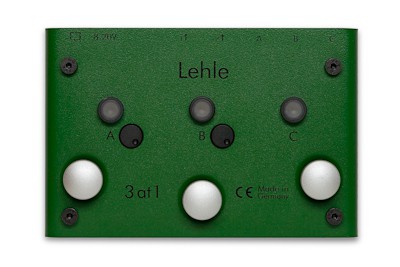
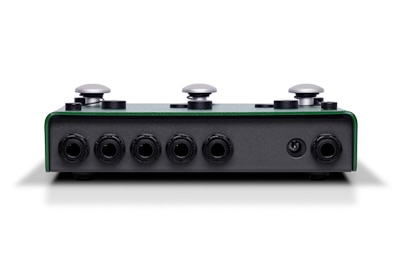
Q: What does SGoS stand for?
A: SGoS stands for Second Generation of Switching. The new series of Lehle switchers features a
TRS socket for connection with other Lehle SGoS switchers and external MIDI equipment for synchronization. SGoS switchers can receive MIDI program change commands and are very easy to program, they can also send MIDI program change commands and function as a MIDI controller.
Q: Can the Lehle 3at1 SGoS be used to switch between 3 totally different instruments?
A: Yes, 2 of the 3 inputs feature a level control for volume adjustment, all sockets and signal paths are fully stereo, this way stereopreamps, keyboards or synthesizers can be connected.
Q: Can both outputs of the Lehle 3at1 SGoS be used simultaneously?
A: No, to guarantee hum free operation a seperate isolation will be required like the P-Split II, Little Dual or Dual SGoS.
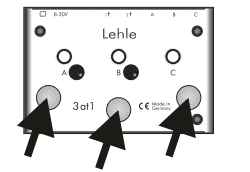
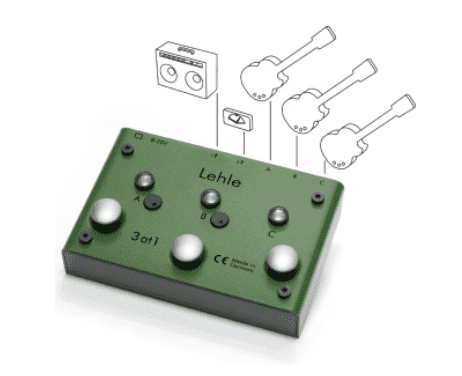
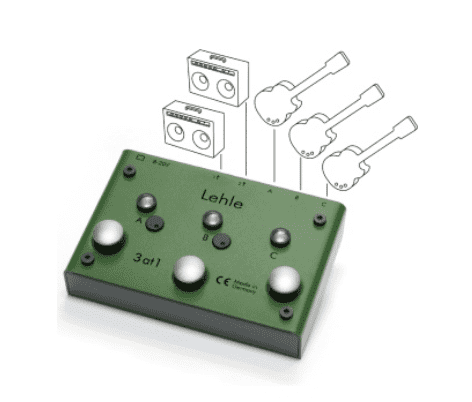
General Description
1 The input signal is routed to the two outputs without semiconductors (2). The volume of the signals present on Outputs A and B can be controlled using the potentiometers (6). Only one input signal (A or B or C) can be routed to an output at any time. The Lehle 3at1 SGoS can switch mono and also stereo signals (see: stereo use of the Lehle 3at1 SGoS). The input signal from A is automatically present on Output 1 when the Lehle 3at1 SGoS is off.
2 These are the two switchable outputs. The input signal from the respective input is present on Output 1 when a footswitch (7) is pressed for the first time. The LEDs (5) indicate this (A =green, B = yellow, C = red). This input signal is switched to Output 2 when the same footswitch is pressed a second time. The LED will now show blue. It is thus possible to switch backward and forward between an amp and a tuner. The output which is not operating is automatically muted, in order to suppress background noise. Outputs 1 and 2 are not electrically isolated! A hum loop can occur if both outputs are used for two amplifiers, due to the ground connection between Outputs 1 and 2. A transformer for electrical isolation (e.g. a Lehle P-Split) interposed between them avoids the hum loop.
3 The Lehle 3at1 SGoS requires an 8 to 20V power supply . The supply voltage is internally filtered and stabilized to guarantee trouble-free operation. A thermal cutout trips the unit automatically if a short-circuit occurs. The correct connector for the power-supply socket of the Lehle 3at1 SGoS is included in the pack. This can be soldered on to the power adapter of your choice. It is advisable to use a separate power adapter or an outlet on a multiple outlet power adapter with electrically isolated outlets for the Lehle 3at1 SGoS, but with no other loads connected to it, to avoid interference noise during operation or when switching.
4 This jack socket is required for networking of the Lehle 3at1 SGoS with other Lehle SGoS Switchers and to transmit or receive MIDI program-change commands. See the “MIDI capabilities of the Lehle 3at1 SGoS” section for more details.
5 The high-intensity LEDs under the lenses clearly indicate Switching State A, B or T, even under stage lighting.
6 The volume of the signals present on Outputs A and B can be controlled using these potentiometers.
7 The foot-switches with their virtually indestructible mechanisms actuate momentary switches inside the switcher which trip Inputs A, B or C, depending on the mode selected.
Mode selection All three foot-switches must be pressed simultaneously to change the mode. When the buttons are kept pressed, the LEDs will start to flash in sequence. After around 3 sec., one LED will remain on longer. A Lehle 3at1 SGoS in Mode 1 will be in Mode 2 after this mode-changing operation. From there, it can be switched to Mode 3, and from Mode 3 back to Mode 1.
Mode 1: Input A is switched to Output 1 when the left-hand footswitch is pressed; the input signal from A is present on Output 2 if the footswitch is pressed again. Use the center footswitch to switch Input B and the right-hand footswitch to switch Input C to Output 1 (press once) or 2 (press twice). The Lehle 3at1 SGoS operates in this mode in default condition.
Mode 2: Mode 2 functions in the same way as Modus 1: Pressing a footswitch once switches the input signal to Output 1, pressing it twice switches it to Output 2. All input and output channels are muted if the same footswitch is now pressed a third time. All the LEDs then go off.
Mode 3: Mode 3 functions in exactly the same way as Mode 1. The Lehle 3at1 SGoS transmits a MIDI program-change command via MIDI Socket (4) as soon as a foot-switch is actuated in this mode. These footswitches are also used to assign switching states to a MIDI programchange command once a MIDI program-change command has been received. Storing is extremely easy: If, after a MIDI program-change command has been received, Input A or B or C is to be routed to Output 1, press the footswitch once and keep it pressed until the green, yellow or red LED flashes and then automatically remains on. The particular input will now be routed to Output 1 every time the Lehle 3at1 SGoS receives this MIDI program-change command. Press the footswitch again if the same input is to be switched to Output 2 when a MIDI program-change command is received. Keep the footswitch pressed until the blue LED flashes and then automatically remains on.
These footswitches are also used to assign switching states to a MIDI programchange command once a MIDI program-change command has been received. Storing is extremely easy: If, after a MIDI program-change command has been received, Input A or B or C is to be routed to Output 1, press the footswitch once and keep it pressed until the green, yellow or red LED flashes and then automatically remains on. The particular input will now be routed to Output 1 every time the Lehle 3at1 SGoS receives this MIDI program-change command. Press the footswitch again if the same input is to be switched to Output 2 when a MIDI program-change command is received. Keep the footswitch pressed until the blue LED flashes and then automatically remains on. These settings are stored in the built-in EEPROM and are not lost even when the unit is switch off. The currently selected mode is backed-up in an Eeprom even after the Lehle 3at1 SGoS has been switched off. 8 The base of the Lehle 3at1 SGoS is designed for trouble-free fixing. The four screws holding the cover in place must firstly be opened and the base of the unit can then be screwed to a base-plate using the two screws, washers and spacers supplied.
Specs
Outputs
- Weight
- 735
- Length
- 10,3 cm
- Width
- 15,6 cm
- Overall Height
- 4,7 cm
- Voltage
- 8-20 V DC
- max Current
- 97 mA